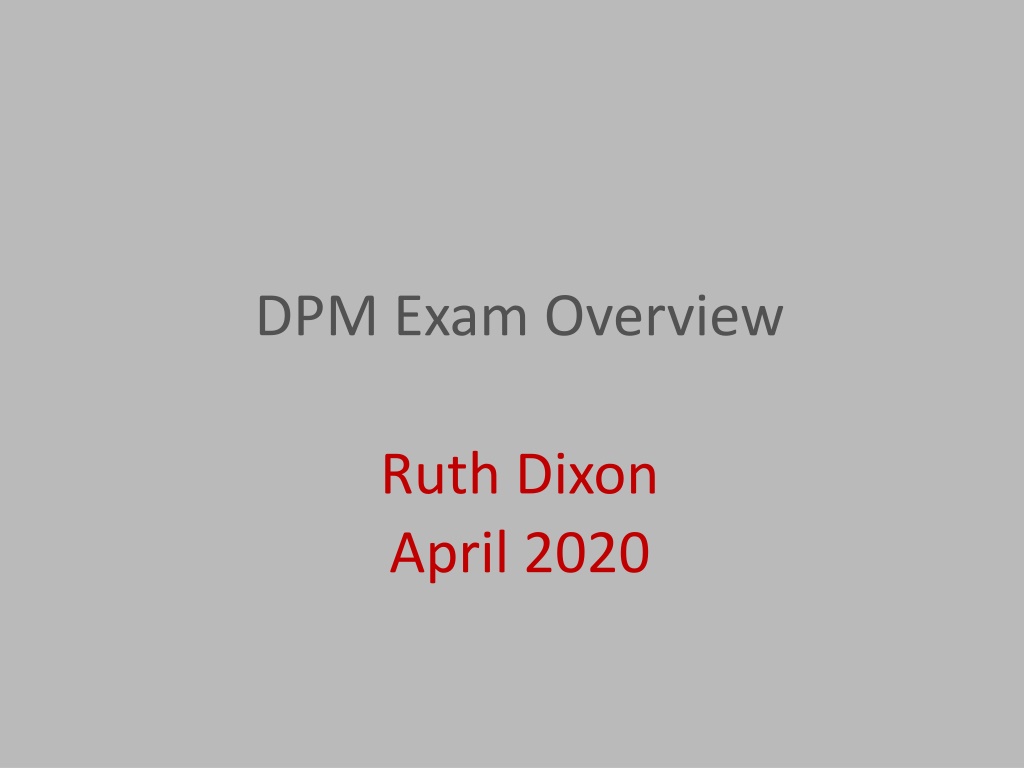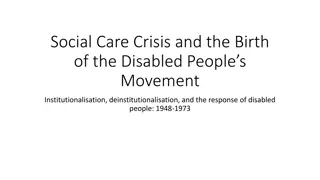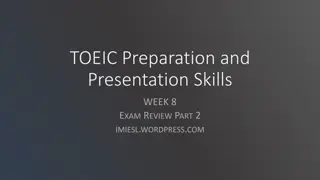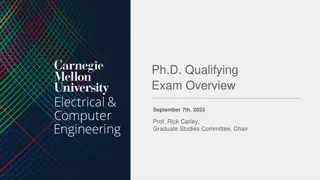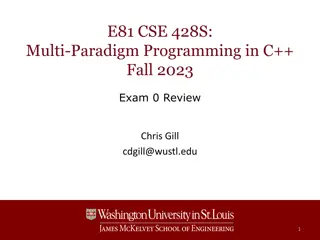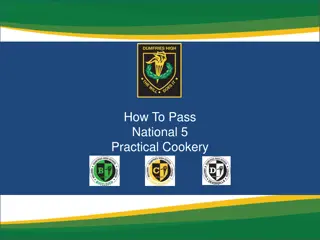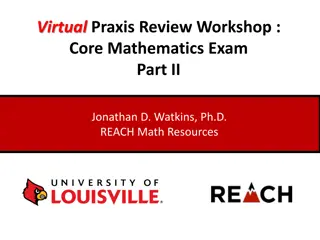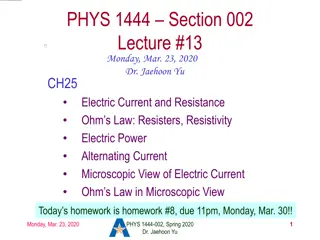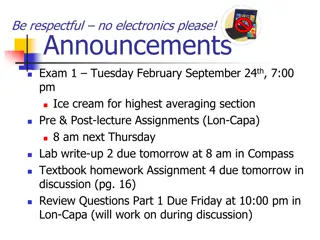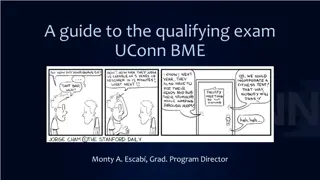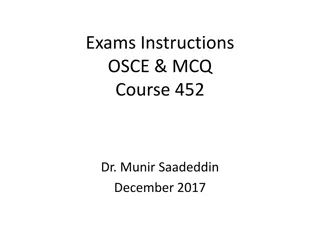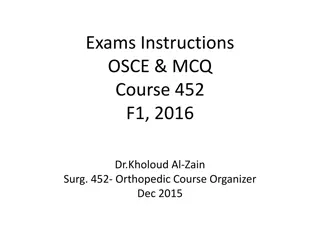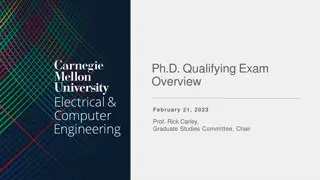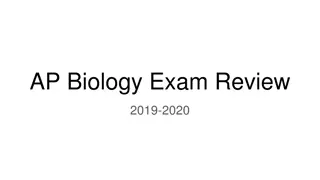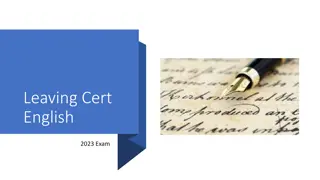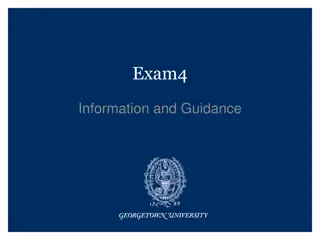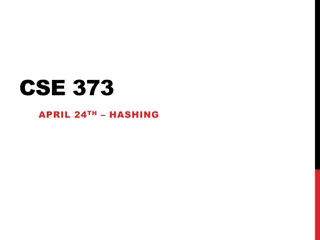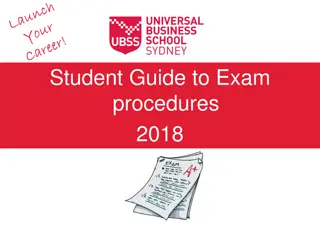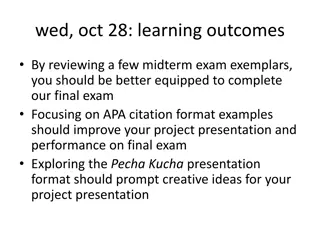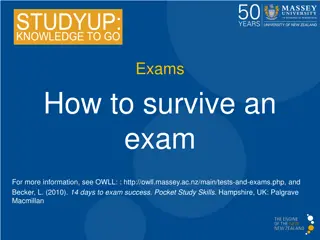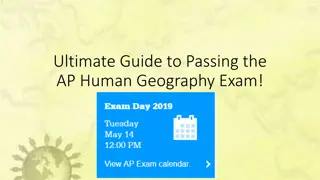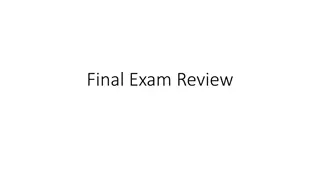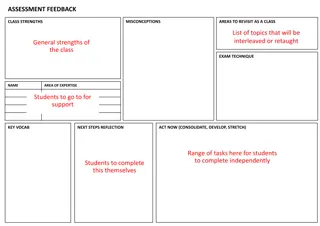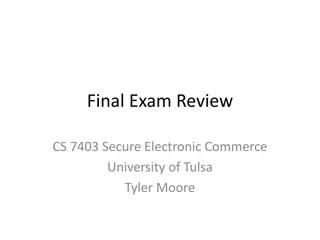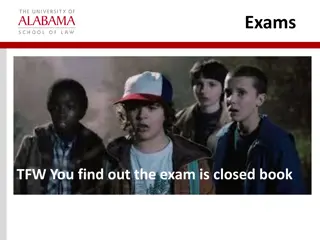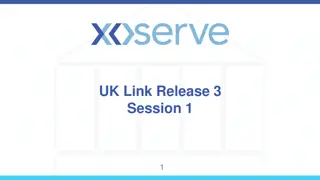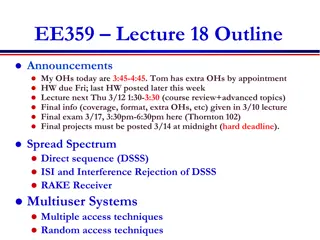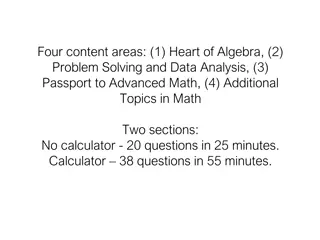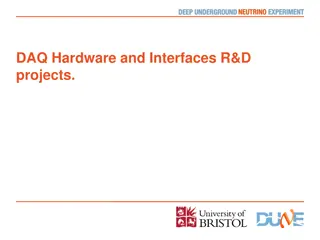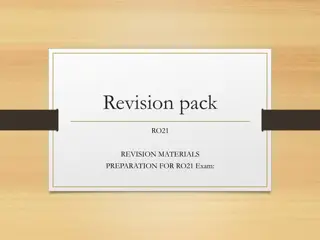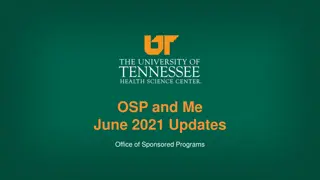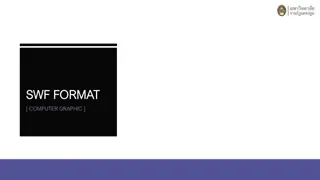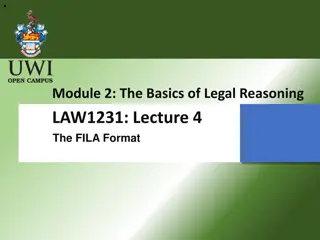Detailed Overview of DPM Exam Format Changes and Current Structure
The DPM exam has evolved over the years, with changes such as the discontinuation of negative marking, introduction of electronic exams, and restructuring into Part 1 and Part 2. Candidates must pass Part 1 before progressing to Part 2, where they face SAQ and CAP assessments. The exam format and requirements have been refined to ensure candidates maintain current knowledge standards. Recommendations for applying to both parts in the same year and details on the exam specifications are provided.
Download Presentation

Please find below an Image/Link to download the presentation.
The content on the website is provided AS IS for your information and personal use only. It may not be sold, licensed, or shared on other websites without obtaining consent from the author. Download presentation by click this link. If you encounter any issues during the download, it is possible that the publisher has removed the file from their server.
E N D
Presentation Transcript
DPM Exam Overview Ruth Dixon April 2020
Contents Overview of DPM MCQ SAQ with examples CAP
Changes to the DPM 1979 2005 2010 2011 2013 2019 2019 2019 First DPM Negative marking stopped in MCQ Viva exam changed to written CAP Essay paper discontinued Diploma split into Part 1 and Part 2 DPM exam uses Pharmatrain 2018 syllabus CPM awarded for Pass in Part 1 MCQ Pass one of the papers in Part 2, don t have to retake it for 3 years Electronic exams 2021
Current format of the DPM exam Part 1 MCQ 75 question stems, each with 5 true/false completions in 2.5 h Held annually in mid September CPM is awarded on passing Part 1 Candidates must pass Part 1 before being eligible to sit Part 2 Candidates may sit both parts same year Part 2 SAQ and CAP SAQ 10 questions in 2.5h Critical appraisal paper (CAP) read and answer questions on a published paper in 2.5h Held annually in mid October DPM is awarded on passing Part 2
Part 1 and Part 2 We recommend applying for both Parts 1 & 2 in the same year If you fail Part 1, you get a refund of Part 2 If you pass Part 1, but defer Part 2, get a refund minus admin fee You cannot take Part 2, if you pass Part 1, in same year unless you ve applied From 2019, if you pass one of the Part 2 papers but fail the other, you only have to retake the paper you failed next time You have to attempt both the SAQ and the CAP together the first time; A pass in one of the Part 2 papers is time-limited, in order to maintain the expected standard for current knowledge across the curriculum: Candidates have 3 opportunities to pass the previously failed paper (generally 3 years) before having to re-sit the paper they already passed. Example: If a candidate takes the Part 2 in 2019, and passes the SAQ but fails the CAP, they then have the yearly sitting in 2020, 2021 and 2022 to pass the CAP separately. If they don t pass the CAP in 2022, they then have to start again with the Part 2 and take both the SAQ and CAP together. The FPM can allow an extension if there are extenuating circumstances
Exam Specification (from 2018 onward) MCQ Paper Required by GMC Provides a more defined structure for the content of the exam Also provides for structured feedback to unsuccessful candidates SAQ Paper
2019 examination Pass rate for MCQ 79.5% Pass rate for Part 2: 43 took Part 2 & 32 passed (74.4%) 3 distinctions 4 failed both CAP and SAQ 4 failed the SAQ only 3 failed the CAP only
Multiple Choice Question (MCQ) Paper
MCQ Paper 75 questions x 5 responses = 375 marks! Time allowed: 2.5 hours No negative marking Each correct answer scores 1 mark Incorrect or no answer scores 0 marks Random answers score 50%
Multiple Choice Questions Test factual knowledge Have a lead-in stem with 5 completions Any number of the completions will be true Sometimes all will be true; sometimes all will be false; mostly there will be a mix of true and false Questions must be: Within the syllabus Worth asking does it matter? Clear and unambiguous In plain English Avoid tricks, such as an accurate statement but the incorrect source e.g., According to ICH GCP, appropriate caution must be exercised in the conduct of medical research that may harm the environment
Pass mark / marking Marking by computer Pass mark is set by a bookmarking technique by a standard setting panel from the BoE The panel reviews each question to see how well it has been answered and any outliers. Pass mark typically 72-73%
Examples from the MCQ Paper According to ICH Good Clinical Practice, a clinical trial protocol must be signed by: .completion . T/F? Question easy all got it correct, no discrimination
Examples from the MCQ Paper The following factors can affect the pharmacokinetic properties of a compound administered orally: .completion . T/F . The top 20% answered the question better than the bottom 20% i.e. good discrimination
Examples from the MCQ Paper With respect to bioequivalence studies: .completion . T/F The bottom 20% answered the question better than the top 20% i.e. less discriminating but not necessarily a problem But in general prompts us to double check was the question correct or ambiguous
Top tips for the MCQ You have to revise! No negative marks so don t leave blanks
Short Answer Question (SAQ) Paper
SAQ Paper 10 questions Tests factual knowledge / ability to interpret data All questions to be answered Candidates must gain marks on at least 8 questions Time allowed 2 hours (15 mins/question) Answer in bullet form style
Pass mark / marking Pass mark for each question set by a panel of experienced examiners before the exam Pass mark typically around 55% A pair of examiners independently mark all scripts for one question Average score taken If >2 marks difference between the examiners, a third marker (blinded to other scores) marks. Median score then taken.
Examples from the 2019 SAQ paper 1 You are the pharmaceutical physician responsible for reviewing the non-clinical data package to decide if a candidate drug should be taken into first in human studies. The data from the repeat dose in vivo dog study show a significant reduction in renal function. (10 marks) Briefly describe 10 important factors/considerations that will help to decide whether to take this candidate drug into first in human studies.
Examples from the 2019 SAQ paper 1 You are the pharmaceutical physician responsible for reviewing the non-clinical data package to decide if a candidate drug should be taken into first in human studies. The data from the repeat dose in vivo dog study show a significant reduction in renal function. Read the question You need to write at least 10 points but you can write more (10 marks) Briefly describe 10 important factors/considerations that will help to decide whether to take this candidate drug into first in human studies. Briefly describe write a few lines for each point, more than just a list.
A good answer might include What dose/exposure did the significant reduction in renal function occur NOAEL and margin to NOAEL Exposure relationship Extent of renal impairment Time to onset Reversible? Histology in the dogs, any renal damage? Class effect? Other species affected Other toxicology findings Mechanism of action for reduced renal function Predicted IC50/efficacy in man and therapeutic window Planned indication in the clinic (risk benefit) Comorbidities in target population ?higher risk Likely con meds could increase risk in target population Duration of dosing intended for efficacy in man single dose vs life- long treatment Is the reduction in RF monitorable?
A poor answer.. Describes a standard non-clinical toxicology package prior to FTIH Suggests carcinogenicity studies Doesn t mention the renal findings Doesn t address the question
Examples from the 2019 SAQ paper 7 a) What is the meaning of expected with reference to an adverse drug reaction (ADR) with an investigational medicinal product? (2 marks) The extent of your answer should be guided by the number of marks available for each part. Don t write a page for one mark! a) What reference would you use to judge whether an ADR is expected: in a clinical trial with an unlicensed medicine? for a spontaneous report with a marketed product? (1 mark) (1 mark) i. ii. a) What is the time-frame for expedited reporting by the Sponsor to regulatory authorities of a: fatal or life-threatening unexpected ADR? serious, unexpected ADR that is not fatal or life- threatening? (1 mark) (1 mark) i. ii. List means just one or a few words for each. a) What is the purpose of the company core datasheet (CCDS)? (2 marks) Don t assume one mark for each bullet! Give them all. a) List the sections of the CCDS that comprise the core safety information. (2 marks)
Examples from the SAQ paper 2 For a healthy volunteer, single ascending dose, first in human study, dose escalation meetings are held. a) Briefly describe the data required to be reviewed during these meetings. (3 marks) b) Briefly describe 4 potential outcomes following review of data at these meetings. (4 marks) a) Briefly describe 3 important logistical considerations for the conduct of each meeting (3 marks)
Examples from the SAQ paper 2 For a healthy volunteer, single ascending dose, first in human study, dose escalation meetings are held. Read the question a) Briefly describe the data required to be reviewed during these meetings. (3 Briefly describe write a few lines for each (more than a list.) marks) b) Briefly describe 4 potential outcomes following review of data at these meetings. (4 marks) a) Briefly describe 3 important logistical considerations for the conduct of each meeting (3 marks)
A good answer might look like a) Safety data Any data listed in the protocol as stopping criteria or required to be reviewed, e.g., specified DLT, SAEs, AEs, safety labs, vital signs, ECGs etc. PK data: Cmax, AUC, etc. in case of any Cmax/exposure stopping rule PD data, if relevant biomarker, e.g. scales, questionnaires, pharmacoEEG, etc. PK/PD relationship Data required to be reviewed b) 4 potential outcomes Escalate as planned per protocol (No concern) Stop further dosing (Study stopping criteria met) Repeat dose level (Signal of unknown significance or issues with conduct of cohort / insufficient subjects/data) Dose at an interim level (Signal of potential concern but monitorable) Protocol amendment to e.g., givea dose greater than that defined per protocol Urgent safety measures/amendments c) logistical considerations: data availability, participants, documentation, timing etc etc
A not so good answer might.. Simply say safety data without further description Talk about the non-clinical FTIH package Talk about something else instead of logistics
SAQ Top Tips You have to revise this is a knowledge paper ANSWER THE QUESTION (you cannot get marks for answering a different question) Use a bullet point format and write legibly please Allow time for attempting all questions score zero in >3 = FAIL Start with questions you can answer easily Marking scheme guides number of points required (but some may be marks --- we are increasingly saying how many answers we require but don t assume) Use past questions to guide revision (although questions are not re-used topics may be similar)
Critical Appraisal Paper (CAP)
CAP Introduction Tests ability to read and critique a scientific paper Fundamental requirement whatever discipline of pharmaceutical medicine you work in Typically 13-14 questions (around 40% factual, 60% critique) No requirement for all questions to be answered but lose marks if you don t! time allowed 2 hours question paper and article given at same time Answer in bullet form style please! (no essays) You DO NOT need specialist knowledge in the disease area of the article
Pass mark / marking Pass mark for each question set by a panel of experienced examiners before the exam Pass mark typically around 31 out of 50 A pair of examiners independently mark all scripts for one question Average score taken If discrepancy between the examiners, the two markers discuss or a third marker (blinded to other scores) can mark.
CAP Be careful what is being asked for: For a factual answer e.g., List or Briefly describe vs. Your critique / opinion e.g. Give reasons for, Explain or Comment on Think .. why is this important .the so what!
http://www.newstruth.co.uk/wp-content/uploads/2012/05/no-traffic-lights.jpghttp://www.newstruth.co.uk/wp-content/uploads/2012/05/no-traffic-lights.jpg Example: Exclusion criterion = presence of a red traffic light Question: Comment on the rationale for the exclusion criteria (do not simply repeat the inclusion / exclusion criteria)
http://www.newstruth.co.uk/wp-content/uploads/2012/05/no-traffic-lights.jpghttp://www.newstruth.co.uk/wp-content/uploads/2012/05/no-traffic-lights.jpg Example: Poor answer = Red traffic light Partial answer = Red traffic light so can t cross the road Good answer = Red traffic light, so can t cross the road because it may be unsafe as high risk of getting run over! What about an exclusion criterion of GFR <30ml/min?
CAP example: description and comment a) Describe in detail how sacroiliitis was determined. (2 marks) b) Comment on the limitations of the radiological investigation in this study (3 marks)
CAP Top Tips Read the whole paper don t just try to look through for the answers don t worry about anything blacked out (redacted) Read the question valid comments not addressing the question will not score any marks Answers should be concise and legible Understand common terms: e.g., design, in lay terms , disposition Note the number of marks available the content of the answer should be roughly proportional to the marks available For the critique questions don t just give statements of fact without the so what or why comments can be about positive as well as negative aspects
http://recursos.ort.edu.ar/static/archivos/portada/381227 CAP summary This is a technique paper o so practice, practice, practice There is no quota to pass / fail o it is up to you http://www.langevin.com/wp-content/uploads/2013/11/practice.gif
Role of BoE and don t forget
Overall Adjudication Part 2 Any candidate who fails SAQ/CAP reviewed Could a small change in a paper affect the overall result? If yes, the marking is reviewed BoE meeting discuss any borderline case / ratify results
Dont forget Work together .... You are not competing with each other (study groups) Look at past papers Don t run out of time Look at the FPM website (past papers, BoE newsletters etc...)
Good luck to those taking the DPM http://www.submerged.co.uk/gfx/k/kitchener5big.jpg Once you have your CCT, we will write to you to join the Board of Examiners Please give something back!
